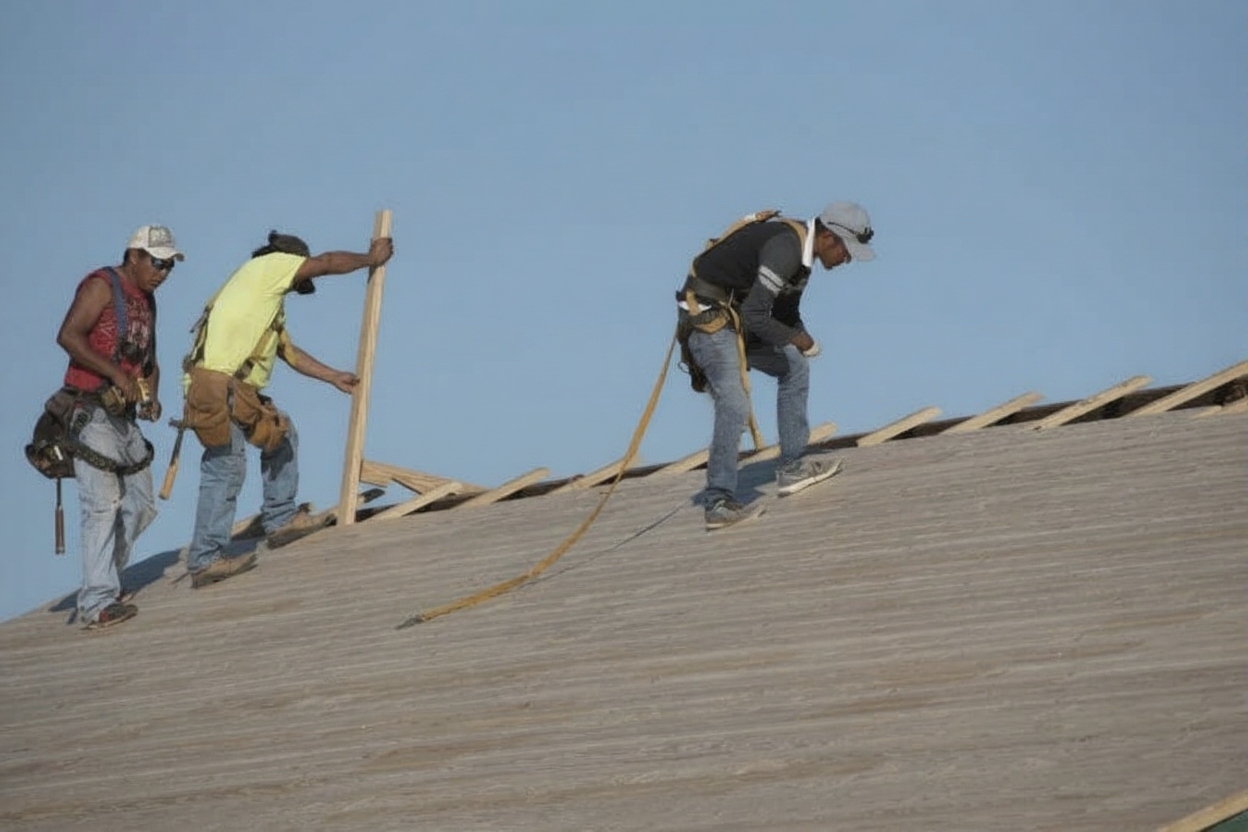
Best Roofing Materials For Florida Homes In 2025
Florida-Specific Roofing & Climate Challenges
November 16,2025
Best roofing materials for Florida homes in 2025

Alt text: Professional roofing team installing metal roof on Florida home with safety equipment under sunny weather
Stepping outside on a Florida summer day, you can feel the intense heat radiating from every surface. Your roof absorbs that heat for hours, and choosing the wrong material can lead to sky-high cooling bills, premature failure, and costly repairs. Florida homes need roofing materials that can handle relentless sun, hurricane winds, humidity, and salt air without breaking down.
Florida roofs face unique challenges: months of UV exposure, tropical storms, high humidity, and coastal corrosion. The right material protects your investment for decades.
At Foxhaven, we help homeowners select roofing materials built for Florida’s demanding climate. This guide walks you through the top options, their performance in heat and storms, and how to choose the best fit for your home and budget.
Why Florida roofs require specialized materials
Florida’s tropical climate creates conditions that destroy ordinary roofing materials quickly. Here’s what your roof battles year-round:
- Intense UV radiation that degrades shingles, tiles, and sealants
- Persistent humidity encouraging mold, algae, and rot
- Hurricane-force winds testing every fastener and seam
- Salt air accelerating metal corrosion near the coast
Without proper materials and regular maintenance, even well-installed roofs fail early. Regular roof inspections in Florida catch problems before they become expensive disasters. Coastal areas face additional challenges from wind uplift dangers and coastal air damage.
Your material choice impacts energy efficiency, storm protection, and long-term value. Let’s examine which options perform best.
Top roofing materials that survive Florida weather
Metal roofing systems
Metal roofs have evolved beyond basic corrugated panels into attractive, high-performance systems. Standing seam metal roofs excel in Florida because they reflect sunlight, resist wind uplift, and last 40 to 70 years.
Advantages:
– Reflects heat, reducing cooling costs significantly
– Excellent wind and impact resistance
– Lightweight and environmentally friendly
– Long lifespan with minimal maintenance
Considerations:
– Higher upfront investment
– Requires periodic coating to prevent corrosion
– Professional installation critical for performance
Metal roofing works especially well for homes prioritizing energy efficiency and hurricane protection. When properly installed, metal systems withstand Category 5 winds and keep interiors cooler than traditional materials.
Tile roofing systems
Clay and concrete tiles define Florida’s architectural character. Mediterranean-style homes throughout the state feature tile roofs because they perform exceptionally well in heat and humidity.
Tile roofs can last over 50 years in Florida’s climate when properly maintained, offering superior insulation and natural heat resistance.
Advantages:
– Naturally heat-resistant with excellent insulation
– Lifespan exceeding 50 years
– Resistant to salt air and UV damage
– Adds significant curb appeal and value
Considerations:
– Heavy weight requires strong structural support
– Higher installation costs than shingles
– Brittle under foot traffic
Before hurricane season, inspect tiles for cracks that could allow water infiltration. Professional maintenance prevents minor issues from becoming major leaks.
Asphalt shingle roofing
Asphalt shingles remain popular for their affordability and variety. Modern architectural shingles offer better performance than older three-tab designs, especially when you choose reflective colors.
Advantages:
– Most affordable initial investment
– Wide range of colors and styles
– Straightforward installation and repairs
– Adequate wind resistance when properly installed
Considerations:
– Shorter lifespan (15 to 25 years) in Florida heat
– Vulnerable to algae growth in humidity
– Lower energy efficiency than metal or tile
Shingles work for budget-conscious homeowners, but require vigilance during Florida’s rainy season when mold and algae thrive.

Alt text: Florida homeowner discussing roofing material samples and options with professional roofing consultant at table
How to choose your ideal roofing material
Consider these factors when selecting your roof:
Budget: Asphalt shingles cost less initially, but metal and tile deliver better long-term value through longevity and energy savings.
Climate exposure: Coastal homes need salt-resistant materials. Inland properties should prioritize heat reflection and UV resistance.
Aesthetic goals: Tile suits Mediterranean architecture, metal works for modern designs, and shingles offer traditional appeal.
Long-term plans: If you plan to stay 20+ years, invest in durable materials like metal or tile.
Energy priorities: Reflective materials and cool roof options significantly reduce cooling costs in Florida’s heat.
Working with experienced roofing professionals helps you balance these factors and make confident decisions.
Foxhaven guides homeowners through material selection, installation, and maintenance to maximize roof performance and lifespan.
Coastal homes benefit from corrosion-resistant materials, while inland properties can prioritize heat reflection and energy savings for optimal long-term performance.

